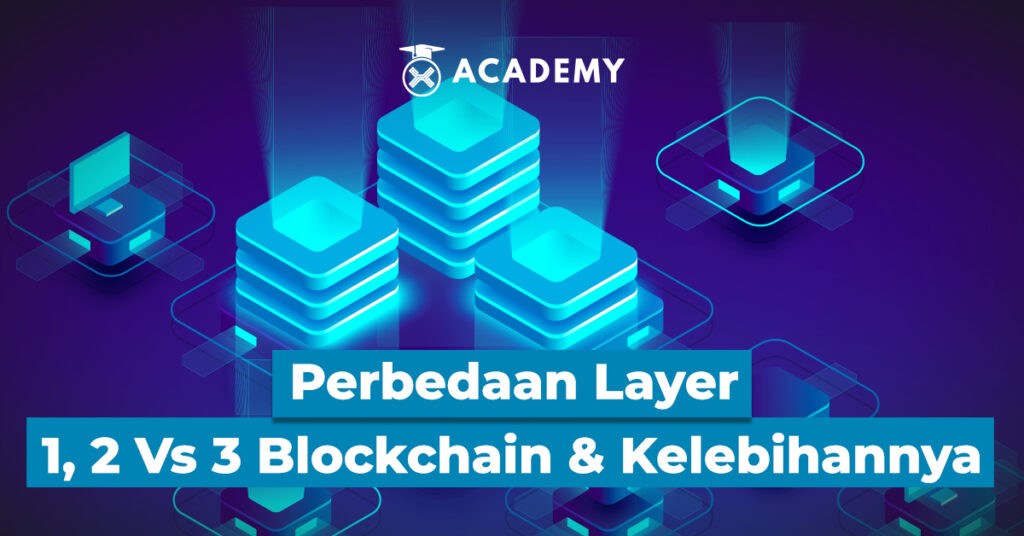Layer 1 and 2 blockchain technologies refer to the structure of the technology used in the blockchain network. Common examples are the relationship between polygons and ethereum or polka dots and parachains.
Layer 1 is the basic form of networks commonly known today, such as Bitcoin, Binance Smart Chain, or Ethereum. The underlying infrastructure of layer 1 blockchain networks allows for the validation and settlement of transactions without dependence on other networks.
Although layer 1 is an early version of the blockchain structure, it has some drawbacks, including the scalability issues faced by the main Bitcoin network.
To address this scalability issue, developers often create layer 2 blockchain protocols that use layer 1 as their foundation while leveraging existing security and consensus.
For example, the lightning network on the Bitcoin network is one example of a layer 2 protocol. The mechanisms in the lightning network allow users to perform transactions quickly before they are recorded on the main chain.
What is Layer 1 Blockchain & What are its Advantages?

The layer 1 blockchain system, often called layer 1, refers to the basic structure in a blockchain network that is the main foundation for a crypto asset. For example, major coins like BNB (Binance Smart Chain), BTC (Bitcoin), and ETH (Ethereum) follow this structure.
Layer 1 is the foundation of any crypto asset with a main blockchain that stands independently without dependence on other networks. In other words, the main network in the blockchain ecosystem operates independently without relying on outside structures.
On the other hand, there are the so-called off-chain protocols, better known as layer 2. This layer is the protocol built on top of the main blockchain.
A new protocol can be classified as layer 1 if it can process and complete each transaction within the main blockchain structure without requiring the involvement of an external network.
The following are some of the advantages of a layer 1 blockchain that are important to know, including the following:
Enhanced Security Features
One of the key advantages of a Layer 1 blockchain is its enhanced security features. By recording transactions directly on the blockchain, layer 1 eliminates the need for intermediaries, reducing the risk of data manipulation or unauthorized access.
The decentralized nature of layer 1 blockchains also ensures that no single entity can control the network, making it highly resistant to hacking or malicious activity.
Scalability and Performance
Layer 1 blockchain solutions are designed to handle larger transaction volumes compared to their layer 2 counterparts. With layer 1, transactions are processed directly on the blockchain, resulting in faster confirmation times and increased scalability.
As a result, layer 1 blockchain networks are better equipped to handle complex transactions globally, making them suitable for applications that require high throughput and performance.
Decentralization and Transparency
Layer 1 blockchain technology reflects the core principles of decentralization and transparency. With no central authority controlling the network, layer 1 blockchain empowers individuals and organizations to participate in transaction validation and decision-making processes.
It builds trust and eliminates the need for intermediaries, bringing transparency to industries historically lacking transparency.
Blockchain Challenges and Trilemmas
Quoting id.beincrypto.com, when developers design a blockchain, they focus on three main aspects: security, decentralization, and scalability. However, until recently, blockchains could only prioritize two aspects.
As a result, one aspect had to be sacrificed to emphasize a more important function. For example, Bitcoin emphasized decentralization and security but had to sacrifice scalability.
Since then, many developers have been working hard to overcome this “blockchain trilemma.” They use various techniques and concepts to solve the scalability problem.
These techniques appear as layer 1 or 2 solutions depending on how their blockchain is implemented. Each layer has its function.
Layer 1 Components
Quoting the page id.beincrypto.com, each element or layer in blockchain technology aims to improve security and scalability. Therefore, the main focus of the layer 1 chain is to address the blockchain trilemma, namely achieving the right balance between decentralization, scalability, and security.
Layer 1 or main chains provide security for decentralized applications that run on top of them. They use strict consensus mechanisms such as Proof of Work (PoW) for Bitcoin, Proof of Stake (PoS) for Ethereum and other variations.
These consensus mechanisms play a key role in the functioning of the layer 1 chain. They determine how layer 1 blockchain security is implemented. For example, Bitcoin, with PoW, relies on nodes to validate transactions and propagate them to the network to update the ledger.
In a PoW environment, miners use computing power to maintain network security. On the other hand, in PoS, such as Ethereum and some Solana blockchains, network validators play a major role in maintaining security. Here, real coin staking is part of the network security mechanism.
In addition, decentralization is an important element in layer 1 operations. The diverse miners, nodes, and validators indicate a fair power distribution. However, scalability is often challenging as more stakeholders can slow the transaction process.
Scaling Solutions and Scaling Techniques
Before discussing the comparison between layer 1 and layer 2 blockchains, it is important to understand some basic concepts, such as scaling on layer 1 blockchains. A layer 1 blockchain network is defined as the main protocol mechanism that is the foundation of a blockchain.
Layer 1 scaling aims to increase the usability of the basic protocol of a blockchain. Therefore, various methods are used to improve the scalability of blockchain networks.
For example, new solutions can be implemented at layer 1 by changing transactions directly on the main protocol rules. The goal is to increase transaction capacity and speed.
In addition, scaling solutions on layer 1 blockchains can increase the transaction capacity to handle more data.
Comparison with Layer 1, 2 Vs Layer 3

Citing the page id.beincrypto.com, diversity in the blockchain world is not just limited to layer 0, layer 1, or even layer 2. Layer 3 blockchain networks like Orbs aim to overcome blockchain trilemmas and scalability issues with innovative approaches.
As for Vitalik Buterin, co-founder of Ethereum, wrote this comment on social media X:
“When layer 1 is affordable enough, I believe everyday transactions will be announced on the blockchain. This is the simplest tool to achieve trustworthy verification, prevent double-spending, and so on.”
As mentioned, layer 1 is the foundation, while layer 2 is responsible for scaling and improving the performance of the main chain. Layer 3 can be thought of as the application layer.
In a building analogy, layer 3 blockchains act as interior improvements to an additional floor, the layer 2 chain. Layer 3 chains pave the way for more advanced blockchain applications and can be used in DeFi, decentralized gaming, NFT marketplaces, and more.
Risks of Blockchain Layer 1, 2, and 3
Quoting the investopedia.com page, although blockchain scaling is a good way to improve transaction handling and increase overall adoption, there are some inherent risks in using scaling solutions, including:
- Blockchain forks: A blockchain is a chain of data blocks that records all transactions in order. Updating a blockchain for scaling may require a fork of that blockchain, which can cause divisions among blockchain advocates. Forking the code allows scaling updates to take place but results in two networks running simultaneously (like Bitcoin and Bitcoin Cash). This can confuse users and decrease the overall value of the cryptocurrency.
- More difficult to verify: Some scaling solutions move transactions to an off-chain network, which means verification does not happen publicly. This lack of transparency can put blockchains at risk of exposure to parties seeking to manipulate transaction data.
Conclusion
In conclusion, layer 1 plays an important role as the main foundation in the blockchain ecosystem. As the basic structure, layer 1 provides the foundation for constructing more complex blockchain applications and protocols.
Despite continued innovation in decentralized networks, the layer 1 blockchain remains the foundation due to its independent security measures, sovereignty, and large user base.
The layer 1 chain also has a common purpose that allows a wide array of developers to innovate and create DApps on top of it. However, for layer 1 blockchains to meet growing needs, they need to become faster. This has led to the development of several layer 2 solutions.
However, it is important to remember that layer 2 does not compete with layer 1. Instead, they should be considered technologies that complement Layer 1 and play an important role in the blockchain network ecosystem.
Invest in Crypto Assets on INDODAX
Now, you understand what layer 1 blockchain is, from its advantages, components, to its comparison with layer 2 and layer 3.
Furthermore, if you are interested in making crypto investments, such as buying bitcoin or buying ethereum or other crypto assets, then you can buy them on INDODAX Market.
For information, INDODAX is the best and most trusted crypto asset trading platform and a pioneer in crypto asset trading in the country.
INDODAX is also committed to providing easy access for investors to the crypto asset market.
As a disclaimer, keep in mind that like other types of investments, investing in crypto assets also carries its own risks.
The risk is related to the fluctuating value of assets and the high level of volatility in crypto assets.
Therefore, it is important to first do research and understand the intricacies of crypto assets before starting to invest.
So, let’s start investing in crypto assets right now only on INDODAX!








 Polkadot 10.08%
Polkadot 10.08%
 BNB 0.32%
BNB 0.32%
 Solana 5.41%
Solana 5.41%
 Ethereum 1.84%
Ethereum 1.84%
 Cardano 1.53%
Cardano 1.53%
 Polygon Ecosystem Token 2.66%
Polygon Ecosystem Token 2.66%
 Tron 2.47%
Tron 2.47%
 Market
Market


